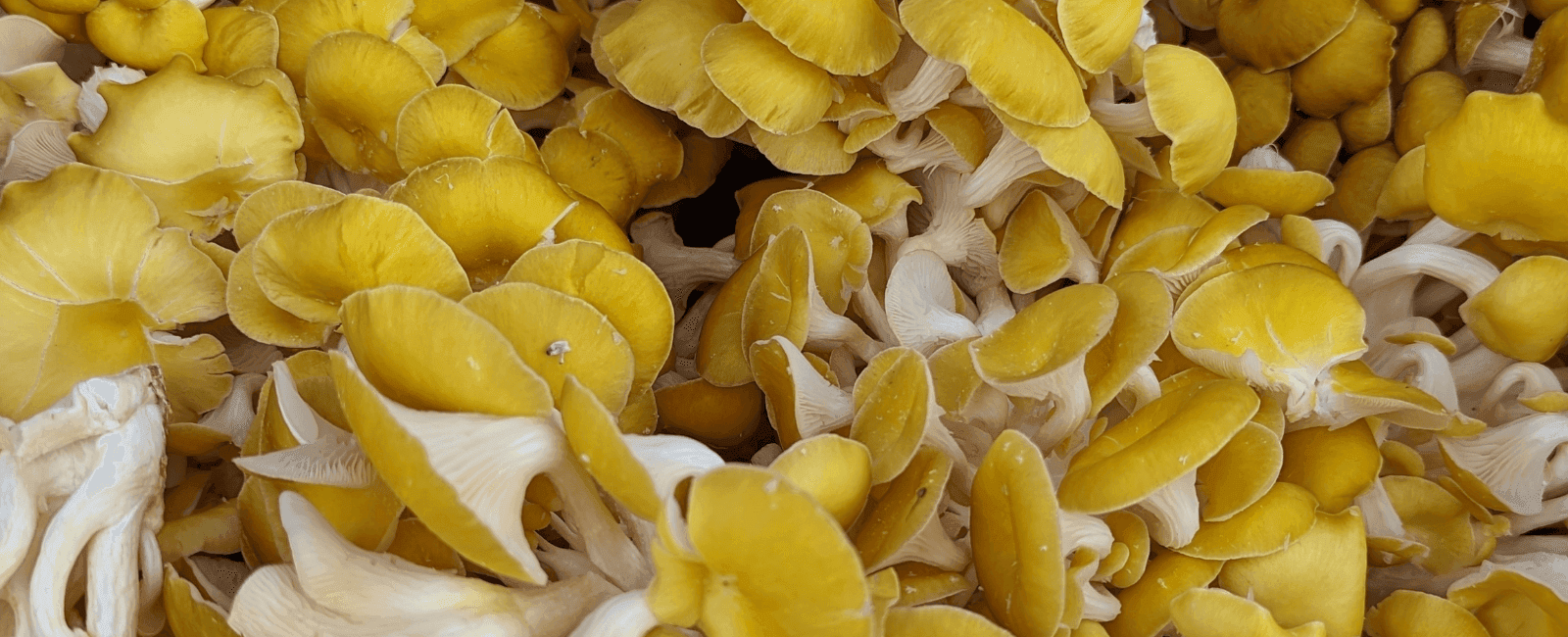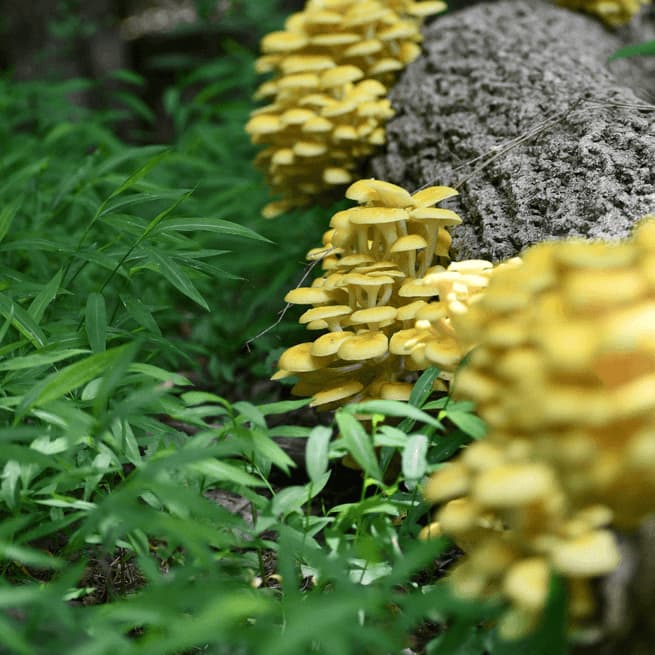

When we think about invasive species, we usually associate them with plants and non-native animals. However, mushrooms can also be highly invasive to the environment, spreading quickly and posing a threat to local native species. Within the past decade, foragers and mycologists have noted a concerning increase in non-native golden oyster mushrooms throughout forests in North America.
Even renowned mycologist Paul Stamets contemplated that golden oysters could eventually establish themselves as wild mushrooms across the U.S. In his comprehensive guide titled Growing Gourmet and Medicinal Mushrooms, published in 2000, Stamets speculated the possibility of the golden oyster mushroom escaping. He notes, “With the onset of commercial cultivation of these mushrooms adjacent to woodlands in North America, it will be interesting to see if these exotic varieties escape.” Unfortunately, Stamets was correct, and the golden oyster somehow did escape at some point.
The golden oyster, otherwise known as yellow oyster mushrooms or Pleurotus citrinopileatus, is originally from Northern China, Eastern Russia, and Japan, yet they’ve become increasingly common as an invasive species in certain U.S. regions. Though this edible mushroom is known for its beautiful yellow color and delicious flavor, its invasive native and frequent sightings have been concerning scientists and pose a threat to the natural ecosystems.
How golden oysters are taking over U.S. forests

Golden oyster mushrooms prefer warm, subtropical climates. Therefore, they have been flourishing on hardwood trees and stumps during the spring and summer in the Midwest and North East. These bright yellow decomposers have been reported in Illinois, Delaware, Iowa, Massachusetts, Maryland, Michigan, New York, Ohio, Pennsylvania, Minnesota, and Wisconsin, where they grow abundantly.
Unlike plant seeds, mushroom spores are microscopic and not visible to the naked eye. Mushrooms can release billions of spores in a single day. Since spores are so small and lightweight, air currents carry them as they travel long distances. If proper precautions are not taken, exotic mushrooms can easily spread and take over surrounding forests.
Golden oysters first appeared in American forests around 2012; since then, they have increasingly dominated local ecosystems. Because these mushrooms are white rot fungi, they quickly and effectively decompose wood. Golden oysters compete with native mushroom species since they grow so well and quickly on decaying trees. As a result, native fungi are displaced and suffer further from the effects of habitat loss.
Fungi are vital to ecosystem health, and when native fungi are threatened, there can be adverse effects on the ecosystem’s function. According to Aishwarya Veerabahu, a Ph.D. student from the Univesity of Wisconsin, Madison, anecdotal evidence suggests that golden oysters can bring down dead, standing trees around five years faster than other native decomposers like the native pearl oyster mushroom (Pleurotus Ostreatus). If these mushrooms continue spreading at the same rate, birds and insects will lose much of their vital habitats and can completely change the stability of a once healthy forest ecosystem.
An outbreak of golden oyster mushrooms
Before the early 2000s, the golden oyster mushroom was an uncommon sight in markets and grocery stores. As exotic mushroom cultivation became more common, golden oysters quickly rose in popularity due to their hearty body and bright yellow cap. They are highly versatile in recipes and easy to grow, making them a popular addition to many spring and summer farmer’s markets around the U.S.
There is current speculation amongst the mycology community as to how this non-native mushroom species has taken over forests throughout America. Some believe that disasters or accidents at local commercial mushroom farms, such as floods and fires, could have spread the spores of the golden oyster mushroom, but even smaller-scale mushroom cultivation could be to blame. Many mushroom cultivators grew golden oysters outdoors on logs. But no one considered that these mushrooms that grow so well outside could eventually spread out and prosper in local ecosystems.
Unfortunately, it is likely too late to combat this invasive fungus and prevent it from taking over forests in America. Tavis Lynch, chairman of the cultivation committee for the North American Mycological Association, argues, “You will never outrun a fungus ever. The fungus is going to win. We don’t even know what measures we are going to take to abate the quantity that’s out there. It’s either going to find balance or take over.”
While we may not know what the future holds for our forests, we can only hope they can adjust to the golden oyster takeover. The introduction of non-native species can be detrimental to ecosystem health. A single species could threaten the entire local environment, but perhaps the growth will even out and not cause any further damage. Only time will tell, but for now, we should do our best to prevent the further spread of non-native genotypes and remove invasive species from forests to give native species a fighting chance for survival.
Preventing the spread of invasive fungi

Golden oysters are extremely popular amongst growers as they are easy and inexpensive. It takes around ten days for the mushroom’s mycelium to colonize the substrate and another two to five days until the mushroom fruits and is ready to harvest. Many home cultivators use grow kits that are conveniently set up for quick and easy fresh mushrooms. Unfortunately, amateur growers often discard the substrate improperly, leaving it outside for the spores to spread into local forests. Dr. Greg Thorn of Western University in London, Ontario, notes that when exotic mushroom cultivation was in its early stages of popularity, growers did not consider that the spores could eventually escape and grow elsewhere. He suggests, “If you crumble up the grow kit after it stops producing for you, it would likely be taken over by the molds and bacteria in the compost itself.”
So if you’re growing mushrooms at home, ensure that you responsively dispose of your grow kits and bags because non-native species could easily escape and wreak havoc in your local forests. “Treat the spent grow-block as a biohazard—crumble finely and spread on lawn or in garden or in a composter. If you grow them in an apartment, break up the spent block and feed it to your worm composter,” says Dr. Thorn. Make sure you only grow exotic species indoors and limit yourself to native and local species to prevent an outbreak of potentially invasive fungi.
And, yes, you should forage away at this species. Although over-foraging is generally looked down upon, removing the golden oyster from forests will do more harm than good, as it gives native fungi a better chance at combatting the invasive mushroom. Typically, when you harvest mushrooms, you should carry them in a mesh bag to aid in the spread of spores, but if you’re ever harvesting an invasive species, opt for a paper bag to allow airflow while reducing the release of more invasive spores around the forest. Responsible foraging and growing practices will help preserve native fungi and protect the integrity and health of deciduous hardwood forests around America.


